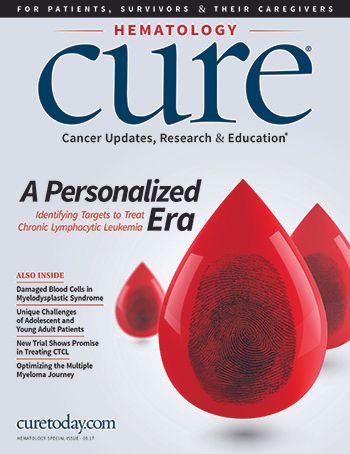Publication
Article
CURE
Advances Lead to Higher Cure Rate for Rare Leukemia Type
Author(s):
Treatment advances mean high cure rate for patients with APL.
JULIANNA GUEVARA was diagnosed with cancer at 23 weeks pregnant with her daughter. - PHOTO BY ELENA EFREMOVA

JULIANNA GUEVARA was diagnosed with cancer at 23 weeks pregnant with her daughter. - PHOTO BY ELENA EFREMOVA
After four and a half years of trying to get pregnant, Julianna Guevara had finally made peace with the idea of never bearing a child. So when she took a routine pregnancy test in November 2016, prior to taking Mucinex for a cold, the 32-year-old from Pembroke Pines, Florida, was stunned to see the test come back positive.
Her baby would be a miracle in more ways than one: Guevara partly credits her then-unborn daughter with saving her life from cancer. While nine weeks pregnant, Guevara learned that another pregnant woman, whom she had been following on Instagram, lost her baby because of a pregnancy complication in the mother’s liver called intrahepatic cholestasis of pregnancy (ICP). The major symptom was extreme itching, especially on the palms and feet — a symptom Guevara was experiencing. At 19 weeks, she was diagnosed by her obstetrician (OB) with ICP too. As risky as ICP is, the blood work Guevara now needed to get every two weeks would become crucial just four weeks later.
A high fever and rapid heart rate sent Guevara to her OB, who referred her to a hematologist. The hematologist suspected flu, but when he saw Guevara’s blood work from ICP checkups before her illness, he immediately admitted her to the hospital. She had flu and pneumonia, but a bone marrow biopsy revealed another diagnosis: acute promyelocytic leukemia (APL).
APL is a subtype of acute myeloid leukemia (AML), which is one of the four main types of leukemia. With AML, blood cells produced in the bone marrow do not mature normally and begin to crowd out the normal cells. What distinguishes APL from other leukemia types is the specific genetic mutation that prevents maturation of white blood cells. A translocation occurs between chromosomes 15 and 17 such that the promyelocytic leukemia protein (PML) gene on chromosome 15 fuses to the retinoic acid receptor alpha (RARA) gene on chromosome 17.
The RARA gene is responsible for producing the protein that ensures normal maturation and differentiation of new white blood cells, and the PML gene produces a protein that stops cells from growing out of control. But the fusion gene produces an abnormal protein, PML-retinoic acid receptor, alpha (RARa), that does the opposite of the PML and RARA genes: The white blood cells never mature beyond their promyelocyte stage (giving the leukemia its name), and they grow uncontrollably. Researchers don’t yet know what causes this mutation, but it’s neither inherited nor present at birth.
APL is among the less common leukemias, making up an average of 10 percent of all AML cases in the United States. The rates are higher, however, in Latin America because this cancer occurs more frequently in those of Hispanic origin, explains Elihu Estey, M.D., professor of hematology at the University of Washington School of Medicine and director of AML clinical research at Fred Hutchinson Cancer Research Center, both in Seattle.
He says people who develop APL also have a higher likelihood of obesity. This appears to be related to abnormalities in the leptin — the hormone that controls how full someone feels after eating — receptors, which also play a role in blood cell differentiation. Patients with APL tend to be younger, often in their 30s to 50s, than those with AML, who are more frequently in their 60s to 80s. Guevara, who is Latina, was stunned, particularly because she practiced a healthy lifestyle involving CrossFit workouts, eating organic food and skipping all meat except fish for five years.
“I was doing everything I could to avoid cancer,” Guevara says. But after all she had been through, her reaction was counterintuitive. “Getting that news, I felt a peace come over me. I just knew we were going to be OK.” And Guevara was right. Much like most patients with APL, she was OK. Outcomes are good if the cancer is diagnosed early and treated appropriately.
Patients typically come in with an infection, fatigue or shortness of breath, generalized symptoms that can occur with many conditions. The only distinctive symptoms are abnormal bleeding or bruising, although not all patients experience those, explains Matthew Mei, M.D., assistant professor of hematology at City of Hope National Medical Center in Duarte, California. Once a blood test reveals very low blood counts, the doctor orders testing — fluorescence in situ hybridization, often referred to as FISH; molecular polymerase chain reaction; or chromosomal karyotyping — to look for the 15;17 translocation.
But even before those results come back, doctors who suspect APL usually start patients immediately on all-trans retinoic acid (ATRA).
“APL can come on very explosively. It can be so aggressive that you start bleeding that day,” Mei says. Roughly 10 to 15 percent of patients with APL die very early, right around or even before diagnosis, from internal hemorrhaging, he added.
“The major cause of treatment failure is early death from this propensity to hemorrhage, since it can be very sudden,” Estey says.
Patients will also receive multiple blood transfusions early on to replace platelets and fibrinogen, a protein that helps blood to clot, explains Martin Tallman, M.D., hematologic oncologist, chief of Leukemia Service at Memorial Sloan Kettering Cancer Center in New York City.
“Although uncommon, APL is highly, highly curable,” Tallman says. “It’s a remarkable story that we’re able to not only cure this disease but cure it without chemotherapy.”
But when Guevara was diagnosed, she didn’t know any of this.
“I didn’t want to know the survival rate for my daughter or myself because it wasn’t going to help me,” she says. “I chose to keep my head in the sand for my family. I had my daughter’s life to fight for, and that gave me the extra bravery I needed.”
TREATMENT PROTOCOLS FOR APL
Thanks to three major advances since APL was first identified in 1957, the once highly fatal disease now sees complete remission rates of 90 percent and cure rates of 80 percent and even higher rates among low-risk patients.
The earliest treatments put only 5 to 14 percent of patients into remission, but the arrival of the chemotherapy agent daunorubicin in 1973 increased those rates to the 50 to 60 percent range and nearly halved the death rate. Then came a big breakthrough in the ’80s with the discovery of ATRA, a derivative of vitamin A that “opened a new era in the treatment of APL,” according to a 2015 article in Blood Cancer Journal.
“It was really the introduction of retinoid acid that dramatically changed outcomes,” Tallman says. “Before that, APL had a high mortality rate because of catastrophic bleeding in the central nervous system most commonly but also on the gastrointestinal tract.”
ATRA works by inducing the malignant white blood cells to mature normally, the first time a treatment countered cancer by encouraging normal development of the cells instead of outright killing them, Tallman says. Although ATRA could lead to complete remission in about 85 percent of patients, it wasn’t enough to completely cure people. Relapses from ATRA therapy alone were frequent, so the standard therapy became ATRA with daunorubicin or a similar chemotherapy agent, idarubicin.
The final breakthrough came in the 1990s with the discovery of arsenic trioxide’s therapeutic success. Although initially approved by the Food and Drug Administration as a second-line therapy in 2000, arsenic has now become standard first-line therapy because it’s so incredibly effective. Like ATRA, it induces differentiation and maturation of the malignant cells, but it also induces programmed cell death in those cells, allowing healthy cells to grow. ATRA and arsenic are now the backbone of all APL treatment protocols, Mei says, raising the cure rate into the 90 percent rate or higher range where it is today.
The use of these treatments also represents “one of the first and best examples of the future, which is precision medicine, the concept of providing specific targeted therapy for a patient with a specific molecular genetic abnormality,” Tallman says. “ATRA and arsenic specifically target the PML-RARa fusion protein.”
The next question was whether chemotherapy was needed at all. Estey was at MD Anderson Cancer Center in Houston when it became the first cancer treatment center in the United States to try a treatment protocol without a chemotherapy agent after seeing results from a Chinese study that suggested ATRA and arsenic were enough. “We said, ‘Well, maybe we only need to give ATRA and arsenic and not do chemotherapy,’” Estey says. Despite receiving some criticism for altering a treatment plan for a disease that already had a 90 percent cure rate, MD Anderson showed that using ATRA and arsenic alone led to complete remission in 96 percent of low-risk patients. Lowrisk patients are those with a white blood cell count of 10,000 or less and represent about 75 percent of all patients with APL. The remaining quarter are high-risk, with a white blood cell count above 10,000 and a higher risk of early hemorrhaging.
The ATRA-arsenic protocol cured only 79 to 81 percent of highrisk patients, so they continued to receive chemotherapy.
Then, in 2013, Italian researcher Francesco Lo-Coco published a critical study in the New England Journal of Medicine showing that treatment with ATRA and arsenic without chemotherapy led to better remission rates than with chemotherapy in low-risk patients. Highrisk patients are still recommended to receive chemotherapy on top of the ATRA and arsenic therapy.
“It turns out the treatment is probably less toxic,” Tallman says. “With that approach, we really cure 98 percent of low-risk patients.” The other 2 percent are patients who relapse but may still be cured by adding chemotherapy. High-risk patients remain at high risk for early hemorrhaging but have a similarly high cure rate when treated with ATRA, arsenic and chemotherapy — as long as they are treated quickly enough. The biggest obstacle that researchers haven’t been able to beat is the early death rate from hemorrhaging.
The early death rate is about 10 to 15 percent, higher than the relapse rate, Mei says, and researchers haven’t gotten below that number.
Thus, it’s one of the biggest areas of research. Another area of study is looking for ways to reduce chemotherapy in high-risk patients to reduce its toxicity. Patients typically receive four doses of idarubicin, daunorubicin or sometimes a similar agent, but some trials are looking at using just two doses, Tallman says.
SIDE EFFECTS OF APL THERAPY
Arsenic, like ATRA, can cause problems in the fetus during the first trimester of pregnancy. Initially, Guevara received only ATRA. But just over a week after starting the ATRA, she developed stomach cramps and shortness of breath.
“I kept trying to sleep, but I kept waking up gasping for air,” she says. Guevara went to the hospital and was soon coughing up blood. “They rushed me to the intensive care unit, and everybody was rushing around. It was a 24-hour blur. I was crashing, and they were prepared to take my daughter if I continued to crash. I couldn’t get any oxygen. Thankfully, she remained safe in my womb."
Guevara was experiencing differentiation syndrome, a serious side effect of ATRA. “Your body goes into overdrive and creates a whole army of blood cells at once,” Guevara says. As hordes of white blood cells mature at once, they release cytokines that leak out of the blood vessels and into the lungs and other parts of the body. Fortunately, the treatment is straightforward: a dose of steroids. And if the patient is at risk for it, this can prevent it.
Aside from differentiation syndrome, ATRA and arsenic are mostly well tolerated, Tallman says. Oncologists watch the liver because too much vitamin A can cause abnormal liver function results. They also keep close watch on the heart rhythm because ATRA can affect the QT interval, potentially leading to an irregular heartbeat or, rarely, cardiac arrest. Other side effects may include nausea, dry skin and cracking of the lips and mouth. For Guevara, she also experienced migraines at the start of each cycle of ATRA. In addition, she had hearing issues, ridges in her nails and mucus in her stools. She found solidarity in Facebook support groups and from the Leukemia and Lymphoma Society (LLS).
Then, in July 2016, at 38 weeks, Guevara gave birth to her daughter, Alianna Love, weighing in at 4 pounds, 10 ounces. “She was perfect in every way,” she says. Guevara was able to breast-feed for one month before she began the next round of ATRA and, now that she was no longer pregnant, arsenic. On February 24, 2017, she received her final treatment and was declared cancerfree in the middle of March.
Today, Guevara is actively involved with the LLS young survivors’ group. She encourages people not to wait if they are experiencing unexplained fatigue or bruising. “Unfortunately, we hear too many stories of people who waited too long for diagnosis and then they die soon after,” Guevara says of stories she has read in the Facebook support group.
These days, cancer isn’t a death sentence, she adds. In her case, a new chapter of life has just begun with the daughter she thought she would never have. “Had she come earlier when we were trying, I would have gone undiagnosed,” Guevara says. “She came at just the right time to save my life.”





